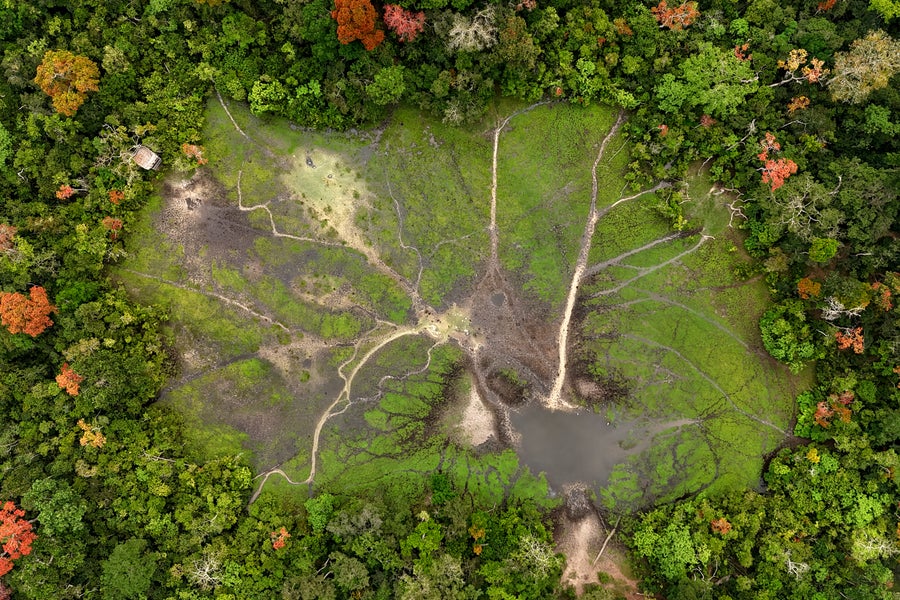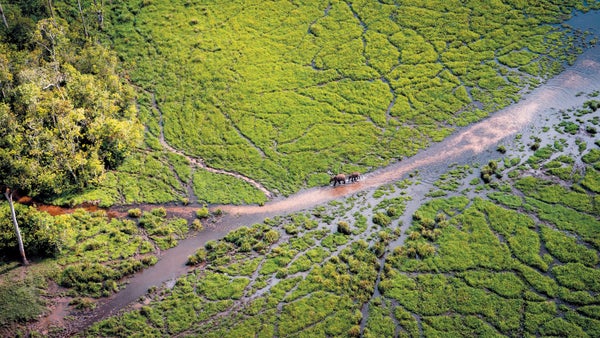Elephants and gorillas that live in the Republic of the Congo’s rainforests spend a lot of time hiding in the shadows—or so we thought. Using drone surveys and artificial-intelligence processing, scientists have discovered an extensive network of mysteriously open grass and sedge clearings among the trees. Elephants, gorillas, and other iconic animals visit these muddy concourses, called bais in the languages of the Indigenous Ba’Aka, to forage for vital nutrition and maintain their intricate social networks. The numerous playgrounds are visible in satellite images, and AI analysis is helping researchers find them more effectively.
Recognizing the surprising extent of the bai network began on the ground. In May 2021 Sylvain Ngouma, a local botanist at Odzala-Kokoua National Park in the north of the Republic of the Congo, led a small team of researchers through the rainforest’s verdant arrowroots. Evan Hockridge, then a second-year Harvard University graduate student, was with Ngouma in search of a thesis idea. As they walked, the forest’s 150-foot canopy of kapok and red ironwood trees abruptly ended at an unobstructed meadow the size of Times Square. Ngouma pointed to a trail of wet, pot-sized footprints leading through the woods to the open rotary and murmured, “Les éléphants.”
“You can’t understand animal interactions without first understanding bais.” —Evan Hockridge Harvard University
On supporting science journalism
If you're enjoying this article, consider supporting our award-winning journalism by subscribing. By purchasing a subscription you are helping to ensure the future of impactful stories about the discoveries and ideas shaping our world today.
Hockridge was planning to study forest animal behavior and had thought bais were anomalies in his data collection. “I had it backward,” he says. “It kind of hit me when I was there: these freaking enormous bais, with buffalo at the front and elephants right in the middle ... you can’t understand animal interactions without first understanding bais.”
For the next three summers Hockridge and his colleagues investigated the clearings. They first sifted through more than two million camera trap images placed around 13 known bais, confirming what many local people had told them—that these natural clearings are crucial gathering grounds for some of the world’s most endangered mammals. Among the regulars: Forest elephants congregate to consume nutrient-rich soil. Western lowland gorillas feed on salt-rich roots of bai plants. Forest buffalo, blue duikers, sitatungas and even bongos—nocturnal, forest-dwelling antelopes with large spiraled horns—graze around bais. The ungulates in turn attract predators such as spotted hyenas and lions. The bais, the researchers realized, are big melting pots, big playgrounds, for a menagerie of forest dwellers.

Elephants and others congregate at a bai playground in the Republic of Congo.
Irene Galera/African Parks
“There is something quite magical in watching a family of elephants, gorillas or giant forest hogs emerge from the forest edge and bask in sunlight and social opportunities before slipping back into the cool shade of the forest interior,” says Vicki Fishlock, deputy director of research at the Amboseli Trust for Elephants, who is not involved in Hockridge and Ngouma’s work. Bais are like Viennese cafés: social arenas where animals hang out. Elephant families meet, and the young get introduced. In open space, they can see one another clearly. The calves play in the mud or, according to Odzala park managers, spend a lot of time chasing birds. Female gorillas get a better look at solitary males and decide whether to join them. Herbivores graze with their calves, perhaps because clearings allow them to more easily spot predators.
During the initial surveys, the team often followed elephant trails—so-called elephant boulevards—to move through the rainforest from bai to bai. This process led Hockridge to wonder about a network. Although previous studies documented animal behavior in selected bais, no one had counted them or had the means to map their distribution.
Doing so required taking to the sky. Partnering with African Parks, a nonprofit organization that manages Odzala, the team flew drones equipped with high-resolution lidar over some of the 220 bais that park rangers already knew about, gathering structural and spectral signatures. The researchers used this information to train a machine-learning algorithm that picked out bais from satellite images. For a study in Ecology, Hockridge and Ngouma mapped all the bais in a national park the size of Connecticut and found 2,176 of them—10 times more than the park management had previously known of. (Disclosure: The writer of this Scientific American article was formerly affiliated with the senior study author’s laboratory at Harvard but was not involved in the work.)

A bai in Odzala-Kokoua National Park in the Republic of the Congo.
Gwili Gibbon/African Parks
Bais are always located near rivers or streams. Most are smaller than a city block, but a few, at more than 100 acres, are larger than some college campuses. “Especially in the West, we often view rainforest as a continuous sea [of trees], but we need to consider where the forests cease to be,” Hockridge says. “Bais are ultimately islands of resources, and animals produce these networks of trails to essentially navigate to and from a nodal network of bais.”
The researchers’ map of bais, the first of its kind, is also a map of conservation priorities. “We find that a huge portion of the animal community is dependent on this unique ecosystem. These species don’t have alternative habitats other than bais,” Hockridge says. “We name a lot of the animals as the forest elephants, the forest buffalo, but if you look at their movement patterns and the amount of time they spend in the bais, they are almost like clearing specialists.”
Observers have been able to clearly see the network only recently as satellite resolution and computation capacity have improved, says senior study author Andrew Davies, an ecologist in Harvard’s department of organismic and evolutionary biology. Davies hopes to apply the same algorithm to chart bais across the entire Congo basin—the second-largest rainforest in the world.
The study is also a step toward solving the ultimate mystery: How did bais form? Many ecologists have argued that a combination of hydrology and animal landscaping, especially by forest elephants, is at play. But definitive proof has been elusive; no one has ever documented their formation or recession. Now, with a map in hand and camera traps still in place, the research team is tracking long-term changes, which have implications for the maintenance of these crucial animal habitats. For example, would rampant ivory poaching affect elephant population and thus bais? Would changing climate cause the bais to shrink or expand?
“We have hypotheses,” Davies confides, “but the short answer is: we don’t know.”
A version of this article entitled “Rainforest Playgrounds” was adapted for inclusion in the January 2025 issue of Scientific American. This text reflects that version, with the addition of some material that was abridged for print.
